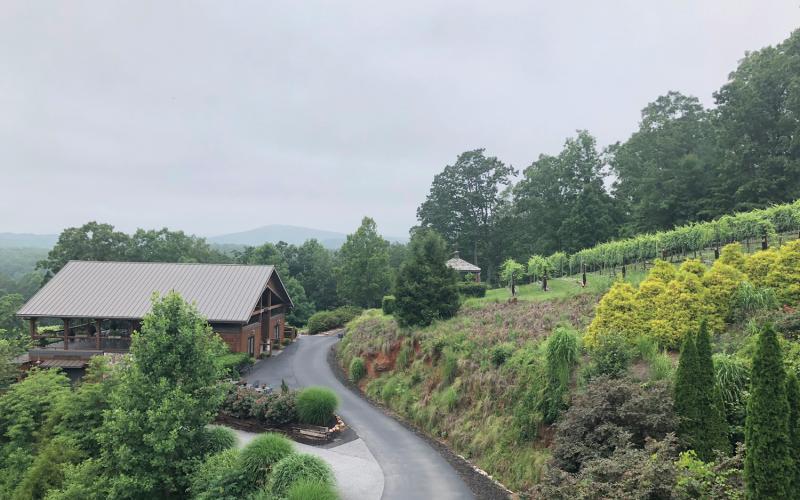“We started it back in ’99.
I was 26,” Brannon Boegner said, describing the early
moments of Wolf Mountain, the winery he and his father,
Karl Boegner, have been raising on a steep Dahlonega slope
for almost two decades.
Those efforts have now brought Wolf Mountain and its neighboring wineries close to a major achievement: their very own regional appellation, the Dahlonega Plateau.
“I had grown up in the hospitality industry—my dad was in hospitality for over 40 years—so I already had a love for wine,” he noted. “We became investors in one of the first vineyards in the area, and we had consultants from California and Virginia help us, but it became a lot of trial and error—different clones and rootstocks. Just see what takes and what starts to do well. A lot was learned from that first vineyard site.
”By 2003, the Boegners produced their first entirely estate-grown wine and had finished construction on the winery, tasting room, and a restaurant. Fifteen years later, that restaurant stays packed every weekend, full of an increasingly savvy crowd.
“We’re seeing more and more young people and people who know what they’re talking about,” Brannon said. “They’ve been all over Napa and now they’re coming here. And they’re surprised. Often, they planned to just stop in, but they’ll end up spending three or four hours here.”
The progress of Wolf Mountain’s wine style has been an incremental evolution over the years, happening mostly in small adjustments every vintage. Brannon has always participated in the winemaking, but he became head winemaker and vineyard manager in 2010, leaving Karl to manage the winery and hospitality aspects of the business.
“When you learn something new, it’s rarely like ‘Oh my god!’. You just pick up little things here and there,” Brannon said, but some of his adjustments have been more radical. In 2012, Brannon made a major change in the aging process for the reds, adding an extra year in barrel, something he felt the wines had always needed. The move left the Boegners with very little wine to sell for a whole year, while the reds continued to age. “Dad didn’t really like that very much,” he remembered.
Wolf Mountain’s progression mirrors that of Georgia wine at large—slow but increasingly steady— and the campaign for Dahlonega’s wineries to garner an AVA (American Viticultural Area—the US equivalent to regional appellations in France or Italy) hasn’t been speedy, but that too is gaining traction. Brannon says they’re close. “It will happen in the next year,” he says. Approval would make Dahlonega Plateau the second AVA in Georgia, and the first whose boundaries are entirely within the state lines.
The award of an AVA—which is controlled by the TTB, a bureau within the U.S. Treasury Department—would mean more than just the prestige of having a bonafide region on your label. It would also create a clear distinction between the serious wines of the area—which, if using the AVA, must be at least 85% fruit from that region—and those of less-forthcoming producers who sneak an abundance of California fruit into what they might pitch as Georgia wine.
“Unfortunately, a lot of the newbies here are taking the cheap and easy way into the business by buying bulk wine from California and just opening their tasting room,” Brannon said. “They don’t plant vineyards and they don’t build wineries.”
But Brannon also admits that working exclusively with Georgia fruit is a risky situation for businesses of Wolf Mountain’s size, which produces 6,000 cases of wine each year, selling nearly all of it directly through the tasting room and to wine club members. “I’ve been doing this for eighteen years and three times we’ve lost the entire crop of whites to frost,” he said. “You’ve got to have a plan B.” To compensate, the Boegners do often supplement their supply with fruit from growers in California, but these wines have different labels and don’t claim to be from Georgia. That transparency is a distinguishing feature, an ethic they share with the best of their local contemporaries.
Getting on the AVA map requires exactly that kind of maturity from the area’s wineries. It isn’t easy, either.
“You basically petition the Federal Government. And they’re very particular in what you have to prove, like the uniqueness of the area, the microclimate, soil—what separates you from everybody else,” Brannon said. “And now, we’ve made it through pretty much every stage of that process. For us, it’s huge.”

